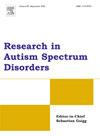Cognitive and emotional empathy in neurotypical individuals with high autistic traits: The role of emotional valence
IF 2.2
4区 医学
Q1 EDUCATION, SPECIAL
引用次数: 0
Abstract
Background
Empathy is an important ability in social interactions, and previous findings regarding empathy of high autistic traits (AT) have been mixed.
Method
The current study sought to investigate cognitive empathy (CE) and emotional empathy (EE) in neurotypical individuals with high AT, examining their responses to both positive and negative emotions in comparison to a matched control group within a sizable sample. Participants were 908 young Chinese adults in the neurotypical range who self-reported their AT using the Autism Quotient and Broad Autism Phenotype Questionnaire and then completed the Multifaceted Empathy Test.
Results
The results showed that the high AT group exhibited less CE, lower EE for positive emotions (EE-P), and intact EE for negative emotions (EE-N) compared to the low AT group. Except for EE-N, other empathic components were positively correlated with AT. The CE-P (i.e., cognitive empathy for positive emotions), CE-N (i.e., cognitive empathy for negative emotions), and EE-P showed a significantly moderate discriminatory effect in predicting AT in neurotypical adults.
Conclusions
Together, these results underscore that the performance on empathy of neurotypical individuals with high AT was moderated by emotional valence of stimuli. Specifically, neurotypical adults with high AT showed a general reduction in CE and a selective decrease in EE. Their EE-P was lower but EE-N was intact.
具有高度自闭症特征的神经畸形人的认知和情感共鸣:情绪情感的作用
背景移情是社会交往中的一种重要能力,以往关于高自闭症特质(AT)的移情研究结果不一。方法本研究试图调查高自闭症特质的神经典型个体的认知移情(CE)和情感移情(EE),在一个可观的样本中,与匹配的对照组相比,考察他们对积极和消极情绪的反应。结果表明,与低自闭症商数组相比,高自闭症商数组表现出较低的共情指数(CE)、较低的积极情绪共情指数(EE-P)和完整的消极情绪共情指数(EE-N)。除 EE-N 外,其他移情成分均与 AT 呈正相关。CE-P(即对积极情绪的认知移情)、CE-N(即对消极情绪的认知移情)和 EE-P 在预测神经畸形成人的 AT 方面表现出明显的中等辨别效果。具体来说,具有高 AT 的神经畸形成人的 CE 值普遍降低,而 EE 值则有选择性地降低。他们的 EE-P 值较低,但 EE-N 值保持不变。
本文章由计算机程序翻译,如有差异,请以英文原文为准。
求助全文
约1分钟内获得全文
求助全文
来源期刊

Research in Autism Spectrum Disorders
Multiple-
CiteScore
4.20
自引率
8.00%
发文量
108
期刊介绍:
Research in Autism Spectrum Disorders (RASD) publishes high quality empirical articles and reviews that contribute to a better understanding of Autism Spectrum Disorders (ASD) at all levels of description; genetic, neurobiological, cognitive, and behavioral. The primary focus of the journal is to bridge the gap between basic research at these levels, and the practical questions and difficulties that are faced by individuals with ASD and their families, as well as carers, educators and clinicians. In addition, the journal encourages submissions on topics that remain under-researched in the field. We know shamefully little about the causes and consequences of the significant language and general intellectual impairments that characterize half of all individuals with ASD. We know even less about the challenges that women with ASD face and less still about the needs of individuals with ASD as they grow older. Medical and psychological co-morbidities and the complications they bring with them for the diagnosis and treatment of ASD represents another area of relatively little research. At RASD we are committed to promoting high-quality and rigorous research on all of these issues, and we look forward to receiving many excellent submissions.
 求助内容:
求助内容: 应助结果提醒方式:
应助结果提醒方式:


